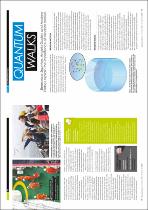JavaScript is disabled for your browser. Some features of this site may not work without it.
- ResearchSpace
- →
- Research Publications/Outputs
- →
- Journal Articles
- →
- View Item
| dc.contributor.author |
Sephton, Bereneice

|
|
| dc.contributor.author |
Dudley, Angela L

|
|
| dc.contributor.author |
Forbes, A

|
|
| dc.date.accessioned | 2018-01-04T10:43:33Z | |
| dc.date.available | 2018-01-04T10:43:33Z | |
| dc.date.issued | 2017-12 | |
| dc.identifier.citation | Sephton, B.C., Dudley, A.L., and Forbes, A. 2017. Quantum walks. Quest, vol. 13(4): 15-18 | en_US |
| dc.identifier.issn | 1729-830X | |
| dc.identifier.uri | http://research.assaf.org.za/handle/20.500.11911/91 | |
| dc.identifier.uri | http://hdl.handle.net/10204/9906 | |
| dc.description | Article published in Quest, vol. 13(4): 15-18 | en_US |
| dc.description.abstract | Bereneice Sephton, Angela Dudley and Andrew Forbes explain the importance of random motion. So, what exactly is random motion? The answer can be dated back to 1827 when a botanist, Robert Brown, noted the movement of pollen floating on water (Fig. 1). He saw that the tiny bits of pollen moved in many random directions, but did not actually go anywhere – they had no overall displacement. This tied in with the study of atoms and this movement was eventually shown to come from the random motion of fastmoving molecules that hit the pollen grains from all sides. However, different sides of the pollen experienced slightly greater forces than others, which resulted in the random movement of the pollen itself. Soon after this, in 1905, Einstein provided the mathematical foundation for this phenomenon, consolidating random motion as a foundation in many scientific studies today. Understanding and being able to predict such motion lies in our ability to simulate it. However, how do you do this when the basic feature of something that is random is that there is no definable pattern and thus should not be predictable? The answer lies in the concept of the random walk. | en_US |
| dc.language.iso | en | en_US |
| dc.publisher | ASSAf | en_US |
| dc.relation.ispartofseries | Worklist;19967 | |
| dc.subject | Random motion | en_US |
| dc.title | Quantum walks | en_US |
| dc.type | Article | en_US |
| dc.identifier.apacitation | Sephton, B., Dudley, A. L., & Forbes, A. (2017). Quantum walks. http://hdl.handle.net/10204/9906 | en_ZA |
| dc.identifier.chicagocitation | Sephton, Bereneice, Angela L Dudley, and A Forbes "Quantum walks." (2017) http://hdl.handle.net/10204/9906 | en_ZA |
| dc.identifier.vancouvercitation | Sephton B, Dudley AL, Forbes A. Quantum walks. 2017; http://hdl.handle.net/10204/9906. | en_ZA |
| dc.identifier.ris | TY - Article AU - Sephton, Bereneice AU - Dudley, Angela L AU - Forbes, A AB - Bereneice Sephton, Angela Dudley and Andrew Forbes explain the importance of random motion. So, what exactly is random motion? The answer can be dated back to 1827 when a botanist, Robert Brown, noted the movement of pollen floating on water (Fig. 1). He saw that the tiny bits of pollen moved in many random directions, but did not actually go anywhere – they had no overall displacement. This tied in with the study of atoms and this movement was eventually shown to come from the random motion of fastmoving molecules that hit the pollen grains from all sides. However, different sides of the pollen experienced slightly greater forces than others, which resulted in the random movement of the pollen itself. Soon after this, in 1905, Einstein provided the mathematical foundation for this phenomenon, consolidating random motion as a foundation in many scientific studies today. Understanding and being able to predict such motion lies in our ability to simulate it. However, how do you do this when the basic feature of something that is random is that there is no definable pattern and thus should not be predictable? The answer lies in the concept of the random walk. DA - 2017-12 DB - ResearchSpace DP - CSIR KW - Random motion LK - https://researchspace.csir.co.za PY - 2017 SM - 1729-830X T1 - Quantum walks TI - Quantum walks UR - http://hdl.handle.net/10204/9906 ER - | en_ZA |






